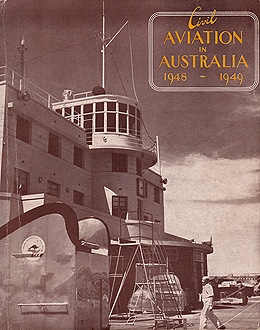
In aviation, the wonder of today is the commonplace of tomorrow, so that the keeping up to date of records is an almost impossible task.
The science of flying is developing with such rapidity that it seems futile to review in detail the work of a past year when so much further progress will occur before that review can appear in print.
In this report is given an account of the activities of the Department of Civil Aviation, which can be seen in true perspective only with the larger activities of the whole of Australian civil aviation in the background.
This
year of 1948-49 continued the transitional period in which our civil air operations
were severely handicapped by continuing wartime shortages. Further deterioration
of dollar resources in sterling areas was still a brake on progress. Early in
the year, steps were taken to reduce the consumption of aviation spirit used by
the airline companies. Much technical equipment needed by the Department and the
operators could not be imported. Equally serious shortages of labour and materials
at home delayed the construction of our great new airports.
But in spite of difficulties, Australian civil aviation forged ahead and traffic figures continued to rise, though at a slower rate than during the immediate post-war years. Larger and faster aircraft came into use on feeder lines as well as on the main trunk routes. By dividing our airlines' passenger miles by the number of our population, we find a passenger mileage flown equal to 92 miles for every man, woman and child in Australia. This is a higher figure than that achieved by any other country. The corresponding average figure for the United States of America was 60, while the Netherlands in third place averaged 50 miles.
In May, 1949, rising costs forced Australian airline companies to raise their fares, which, however, still remained the world's lowest on a passenger mile basis.
In the international field, Australia strengthened her air ties with other nations. Qantas Empire Airways inaugurated a service between Australia and Hong Kong. British Commonwealth Pacific Airlines increased its trans-Pacific service to twice weekly and introduced sleeper-equipped DC.6 aircraft - the largest aircraft on the Australian register. The signing of air transport agreements with India, Pakistan and Ceylon was an augury of the permanent operation of peaceful air services. A survey flight by Qantas Empire Airways to South Africa foreshadowed regular services across the Indian Ocean in the future.
At its third meeting in New Zealand, the South Pacific Air Transport Council was able to review the groundwork established at earlier meetings and plan the future pattern of Commonwealth air transport services in this part of the world. Most significant developments occurred in New Guinea where the aeroplane is making a tremendous contribution to the rehabilitation of the country, and almost every important settlement now enjoys the benefits of scheduled and non-scheduled services.
In the Department itself, the struggle went on to provide ground facilities adequate for the ever-increasing demands. Plans were prepared for years ahead, involving the expenditure of many millions of pounds, with efforts concentrated on the most urgent works at locations where the need was greatest.
Far from standing still, Australian civil aviation was steadily advancing in 1948-49 with surer steps than ever before. The artificial restrictions which limited growth may have been a disguised blessing, preventing the industry from over-reaching itself and risking economic and operational breakdown.
It was a period of consolidation, of planning even greater development.
Back to the main General Organisational History index
Back to the main Industry Regulation & Aviation Policy index
If this page appears without a menu bar at top and left, click here